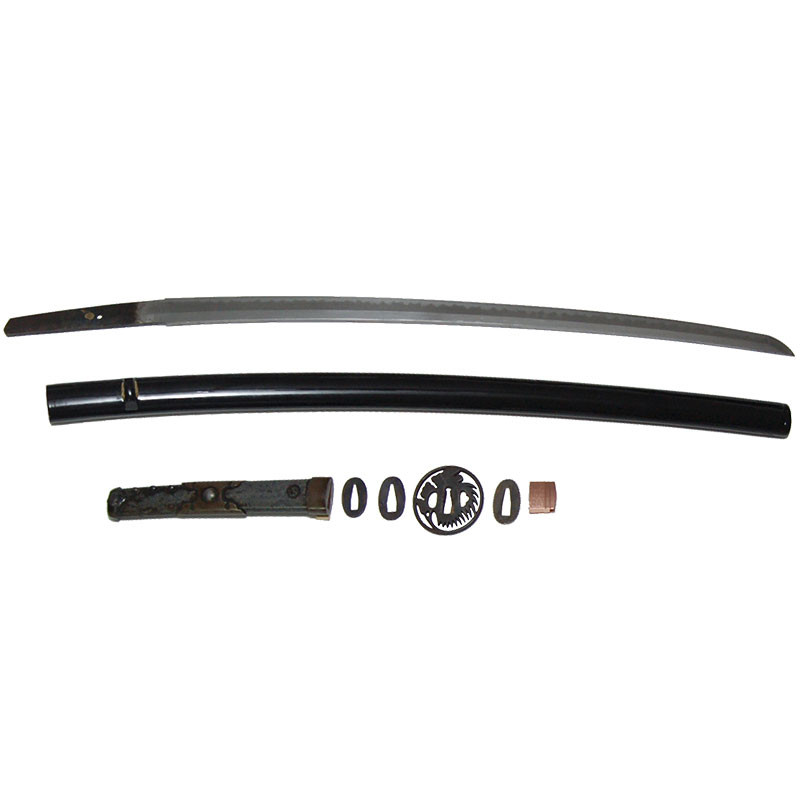














More informations about this product
| Total Weight | 1.112 kg | |
| Weight without Saya | 0.887 kg | |
| Blade Weight | 0.598 kg | |
| Full length Naked Blade (Toshin) |
78.7 cm | |
| Nagasa | 62.9 cm | |
| Tsuka Length | 21.9 cm | |
| Sori (curvature) | 1.55 cm | |
| Kissaki Length | 2.81 cm | |
| Moto Haba | 3.02 cm | |
| Saki Haba | 1.85 cm | |
| Moto Kasane | A = 0.61 cm B = 0.60 cm |
|
| Saki Kasane | A = 0.40 cm B = 0.41 cm |
|
| Curvature | Toriizori (central curvature) | |
| Type Kissaki | Chu Kissaki (Medium length). Fukura very lightly serrated and some visible surface oxydation | |
| Blade Structure | Shinogi zukuri (diamond) with Yaki Mune | |
| Mune | Iori mune (Triangular) | |
| Hamon | Gunome Midare, Toran-Ba, Some Tobi Yaki and Ashi. Quenching line in Nie with much activity | |
| Hada | Ko Itame (pattern of very fine irregular wooden veins) | |
| Boshi | Yagi Sageru Boshi (Komaru Boshi type, returning alonside the Mune), with a Kaen (blazing) Boshi effect on the Omote (Flame shaped) | |
| Nakago | Ubu (unaltered) - Mumei (unsigned), 2 Mekugi Ana, 1 is brass covered. Shape: Ichimonji Gata /Futsu Gata. Ended in Iri Yama Gata Jiri (Dissymetrical V), Yasurime Ō Sujikai & Gyaku Ō Sujikai |
|
| Saya | Kuroro (black shiny laquered) Saya of 225g Saya Lacquered, gilted Shito Dome, Koiguchi strengthened with a black lacquered ring, Hira Kojiri (flat). No setted location for Kogai or Kogatana |
|
| Tsuka & Tosogu (Tsuba, Menuki, Fuchi Kashira) |
- Tsuka: Handle in Tachi type, very particular and rare with steel mounting, covered with shark skin tinted and lacquered, weighting 121g. Unbraided Tsuka, named Kazaritachin, metal parts called Ashikanagu. Metal pins (Tawara-byo) to ensure the grip. - Tsuba: Black Steel, rounded (Maru Gata) with a rounded border (Maru Mimi), Sukashi type openings of Paulownia leaves. Weight of 116g, Size 6.95cm x 7.1cm, Thickness of 0.65cm -Habaki: modern type Shonai Habaki |
|
| Study & Team Review |
Seiryuken Moritoshi: 青龍軒盛俊 (盛寿) Era: from Koka (1844-1848) to Genji (1864-1865) Shinshinto swords era Region: Musashi School: Kato Tsunatoshi & Unju Korekazu Rank: Jyo Saku Moritoshi's real name is Iwamoto Seizaemon (or Kiyouemon). He served under the lord Kikkawa from the Iwakuni clan from which he was the official blacksmith. Being Kiyomaro's student, Moritoshi left Iwakuni for Edo and learned under Chounsai Tsunatoshi (1st generation and Tsunahide's brother). He was so liked by Tsunatoshi (1st gen.) that he became the master of the 2nd Tsunatoshi Generation. He was at first named Seiryusai and later changed it for Seiryuken. Having come back to Iwakuni, he teached to Koretoshi, later named Tsunatoshi (2nd generation). Most of his work is from Bizen tradition, the Hamon are more in Gunome Midare than in Choji Midare. The Hamon are relatively small but full of activities (Hataraki). We can seldom found some Suguha Hamon in a Kanemoto imitation in the Mino tradition. In the early years, the Nakago is a Kurijiri type with Yasurime Kesho. Later on the Nakagojiri became Ha Agari Kengyo with Yasurime generally Kiri. Senryushi Morihide, who produced great Hamon in Gunome Midare, has been his student. Certificate: Jubo Token Kenkyukai JTK #15208, written by Kobayashi Yukinobu in Osaka on September 18th 2015. Kobayashi Sensei is the JTK representative, also known as a a sword polisher. Team Review:
This is a very beautiful blade, well balanced even considering the quite short size. We can observe many particular techniques in the steel and the quenching, a magnificent example of a blade of the Shinshinto times. The very visible quenching make the activity of the blade (Hataraki) easy to see. |
|
Share your opinion
error Your review appreciation cannot be sent
feedback Report comment
check_circle Report sent
error Your report cannot be sent